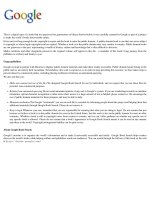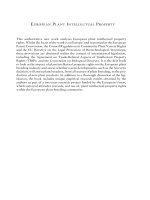INTELLECTUAL PROPERTY PROTECTION IN VLSI DESIGNS pdf
Bạn đang xem bản rút gọn của tài liệu. Xem và tải ngay bản đầy đủ của tài liệu tại đây (6.66 MB, 204 trang )
INTELLECTUAL PROPERTY PROTECTION
IN VLSI DESIGNS
This page intentionally left blank
Intellectual Property
Protection in VLSI Designs
Theory and Practice
by
Gang Qu
University of Maryland‚ U.S.A.
and
Miodrag Potkonjak
University of California‚ Los Angeles‚ U.S.A.
KLUWER ACADEMIC PUBLISHERS
NEW YORK, BOSTON, DORDRECHT, LONDON, MOSCOW
eBook ISBN: 0-306-48717-9
Print ISBN: 1-4020-7320-8
©2004 Springer Science + Business Media, Inc.
Print ©2003 Kluwer Academic Publishers
All rights reserved
No part of this eBook may be reproduced or transmitted in any form or by any means, electronic,
mechanical, recording, or otherwise, without written consent from the Publisher
Created in the United States of America
Visit Springer's eBookstore at:
and the Springer Global Website Online at:
Dordrecht
Contents
List of Figures
List of Tables
Acknowledgments
ix
xiii
xix
1.
DESIGN SECURITY: FROM THE POINT OF VIEW OF AN
EMBEDDED SYSTEM DESIGNER
1
2
Introduction
Intellectual Property in Reuse-Based Design
2.1
2.2
2.3
The Emergence of Embedded Systems
Intellectual Property Reuse-Based Design
Intellectual Property Misuse and Infringement
1
1
2
2
4
8
9
10
12
13
16
16
17
18
19
23
23
26
29
31
Constraint-Based IP Protection: Examples
3.1
3.2
3.3
Solutions to SAT
FPGA Design of DES Benchmark
Graph Coloring and the CF IIR Filter Design
3
4
Constraint-Based IP Protection: Overview
4.1
4.2
4.3
Constraint-Based Watermarking
Fingerprinting
Copy Detection
5
Summary
2.
PROTECTION OF DATA AND PRIVACY
1
2
3
4
Network Security and Privacy Protection
Watermarking and Fingerprinting for Digital Data
Software Protection
Summary
v
vi
INTELLECTUAL PROPERTY PROTECTION IN VLSI DESIGNS
3.
CONSTRAINT-BASED WATERMARKING FOR VLSI IP
PROTECTION
1
Challenges and the Generic Approach
35
36
36
37
37
38
39
40
41
41
42
43
47
52
53
53
54
58
58
61
63
64
65
66
67
69
69
70
72
75
76
78
1.1
1.2
1.3
1.4
1.5
1.6
1.7
Overview
Watermark Embedding Procedure
Signature Verification Procedure
Credibility of the Approach
Essence of Constraint Addition
Context for Watermarking
Requirements for Effective Watermarks
2
Mathematical Foundations for the Constraint-Based Watermarking
Techniques
2.1
2.2
2.3
2.4
Graph Coloring Problem and Random Graphs
Watermarking Technique #1: Adding Edges
Watermarking Technique #2: Selecting MIS
Watermarking Technique #3: Adding New Vertices
and Edges
Simulation and Experimental Results
Numerical Simulation for Techniques # 1 and # 2
Experimental Results
3
2.5
2.5.1
2.5.2
Optimization-Intensive Watermarking Techniques
3.1
3.2
3.3
3.4
Motivation
SAT in EDA and SAT Solvers
Watermarking in the Optimization Fashion
Optimization-Intensive Watermarking Techniques for
SAT Problem
Adding Clauses
Deleting Literals
Push-out and Pull-back
Analysis of the Optimization-Intensive Watermarking
Techniques
The Correctness of the Watermarking Techniques
The Objective Function
Limitations of the Optimization-Intensive Watermarking
Techniques on Random SAT
Copy Detection
Experimental Results
3.4.1
3.4.2
3.4.3
3.5
3.5.1
3.5.2
3.5.3
3.5.4
3.6
4
Summary
Contents
vii
4.
FINGERPRINTING FOR IP USER’S RIGHT PROTECTION
1
2
Motivation and Challenges
Fingerprinting Objectives
2.1
2.2
2.3
2.4
A Symmetric Interactive IP Fingerprinting Technique
General Fingerprinting Assumptions
Context for Fingerprinting in IP Protection
Fingerprinting Objectives
3
Iterative Fingerprinting Techniques
3.1
3.2
3.3
3.3.1
3.3.2
3.3.3
3.3.4
3.4
Iterative Optimization Techniques
Generic Approach
VLSI Design Applications
Partitioning
Standard-Cell Placement
Graph Coloring
Satisfiability
Experimental Results
4
Constraint-Based Fingerprinting Techniques
4.1
4.2
4.3
4.3.1
4.4
4.5
Motivation‚ New Approach‚ and Contributions
Generic Constraint-Addition IP Fingerprinting
Solution Creation Techniques
Solution post-processing
Solution Distribution Schemes
Experimental Results
5
Summary
5.
COPY DETECTION MECHANISMS FOR IP AUTHENTICATION
1
Introduction
2
Pattern Matching Based Techniques
2.1
2.2
2.3
Copy Detection in High-Level Synthesis
Copy Detection in Gate-Level Netlist Place-and-Rout
Experimental Results
3
Forensic Engineering Techniques
3.1
3.2
3.2.1
3.2.2
3.2.3
3.2.4
Introduction
Forensic Engineering for the Detection of VLSI CAD
Tools
Generic Approach
Statistics Collection for Graph Coloring Problem
Statistics Collection for Boolean Satisfiability Problem
Algorithm Clustering and Decision Making
81
81
83
83
84
85
85
87
87
88
90
91
91
92
94
95
101
102
103
105
108
110
111
114
117
117
119
120
122
123
125
125
126
126
128
131
132
viii
INTELLECTUAL PROPERTY PROTECTION IN VLSI DESIGNS
3.3
Experimental Results
4
Public Detectable Watermarking Techniques
4.1
4.2
4.2.1
4.2.2
4.2.3
4.3
4.3.1
4.3.2
4.3.3
4.3.4
4.3.5
4.4
4.4.1
4.4.2
4.4.3
Introduction
Public-Private Watermarking Technique
Watermark Selection and Embedding
Watermark Detection and Security
Example: Graph Partitioning
Theory of Public Watermarking
General Approach
Public Watermark Holder
Public Watermark Embedding
Public Watermark Authentication
Summary
Validation and Experimental Results
FPGA Layout
Boolean Satisfiability
Graph Coloring
5
Summary
6.
CONCLUSIONS
Appendices
VSI Alliance White Paper (IPPWP1 1.1)
References
134
137
137
140
141
142
143
144
144
145
149
150
151
152
152
153
155
157
159
163
163
173
List of Figures
1.1
1.2
1.3
1.4
1.5
1.6
1.7
1.8
1.9
Block diagram of the DCAM-103 digital camera (re-
drawn from the website of LSI Logic Corp.).
ix
Intellectual property reuse-based design flow.
Design technology innovations and their impact to de-
sign productivity.
A Java GUI for watermarking the Boolean Satisfiability
problem.
Layout of the DES benchmark without watermark(left)
and the one with a 4768-bit message embedded (right).
GUI for watermarking solutions to the graph coloring
problem. (top: the greedy 5-color solution to the orig-
inal graph; middle: a 5-color solution with message
UCLA embedded; bottom: a 5-color solution with mes-
sage VLSI embedded.).
Design of the 4th order CF IIR filter with watermark.
(top: control and datapath of the design implementa-
tion; bottom left: control data flow graph; bottom mid-
dle: scheduled CDFG; bottom right: colored interval
graph.).
Constraint-based watermarking in system design pro-
cess‚ (left: traditional design flow; right: new design
flow with watermarking process.).
Fingerprinting in system design process. (left: itera-
tive fingerprinting technique; right: constraint addition
based fingerprinting technique.).
3
5
7
11
12
14
15
17
18
x
INTELLECTUAL PROPERTY PROTECTION IN VLSI DESIGNS
3.1
3.2
3.3
3.4
3.5
3.6
3.7
3.8
3.9
3.10
3.11
3.12
3.13
3.14
3.15
3.16
3.17
3.18
Watermark embedding and signature verification pro-
cess in the constraint-based watermarking method il-
lustrated by the graph coloring problem.
Key concept behind constraint-based watermarking: ad-
ditional constraints cut the original solution space and
uniqueness of the watermarked solution proves authorship.
Pseudo code for technique # 1: adding edges.
Example: a graph with message
embedded as additional edges.
Pseudo code for technique # 2: selecting MIS.
Example: selecting MISs to embed message
Numerical simulation data for technique # 1: the num-
ber of edges can be added in with 0- and 1 -color over-
head for random graph The
curve in between shows the gain (in terms of the number
of extra edges) with one extra color.
Numerical simulation data for technique # 2: the num-
ber of MISs that can be selected to embed signature with
0-‚ 1-‚ and 2-color overhead for graph
Coloring the watermarked graph by technique #
3: adding new vertex (and its corresponding edges) one
by one for [125‚549].
The last 50 instances of graph in Figure 3.9
An example combinational circuit showing the charac-
teristic function representation.
Assumptions for decision problem watermarking.
Pseudo code for SAT watermarking: adding clauses.
Pseudo code for SAT watermarking: deleting literals.
SAT watermarking technique: push-out and pull-back.
The satisfiability of model (redrawn from [58]).
A SAT instance and its watermarked versions‚ (a) The
initial SAT instance; (b) New instance afteradding clauses;
(c) New instance (same spot as initial) and new curves
after deleting literals; (d) New instance after push-out
and pull-back.
Outline of research on constraint-based watermarking.
36
39
43
44
48
49
54
55
57
57
61
63
66
66
68
73
74
79
List of Figures
xi
4.1
4.2
4.3
A symmetric interactive fingerprinting IP protection technique.
Basic template for iterative global optimization.
The generic iterative approach for generating finger-
printed solutions.
84
88
88
4.4
4.5
4.6
4.7
4.8
4.9
4.10
4.11
5.1
5.2
5.3
5.4
5.5
Iterative fingerprinting technique in the system design process.
Two-phase fingerprinting technique for IP protection:
generating n solutions and distributing among m users.
Solution generation phase of the constraint addition based
fingerprinting technique in the system design process.
Duplicating vertex A to generate various solutions.
Pseudo code for vertex duplication.
Manipulating small clique (triangle BCD).
Constructing bridge between vertices B and E to gener-
ate various solutions.
Choosing a triangle from a graph.
Pseudo-code for software copy detection at the instruc-
tion selection level (pre-processing and detection).
Example of how RLF and DSATUR algorithms create
their solutions. MD - maximal degree; MSD - maxi-
mal saturation degree.
Example of two different graph coloring solutions ob-
tained by two algorithms DSATUR and RLF. The index
of each vertex specifies the order in which it is colored
according to a particular algorithm.
Pseudo-code for the algorithm clustering procedure.
Two different examples of clustering three distinct al-
gorithms. The first clustering (figure on the left) recog-
nizes substantial similarity between algorithms and
and substantial dissimilarity of with respect to
and Accordingly‚ in the second clustering (figure
on the right) the algorithm is recognized as similar
to both algorithms and which were found to be
dissimilar.
89
103
104
106
106
107
108
114
121
128
130
133
134
xii
INTELLECTUAL PROPERTY PROTECTION IN VLSI DESIGNS
5.6
5.7
5.8
5.9
5.10
5.11
5.12
5.13
Each subfigure represents the following comparison (from
upper left to bottom right): (1‚3) and NTAB‚ Rel_SAT‚
and WalkSAT and (2‚4) then zoomed version of the
same property with only Rel_SAT‚ and WalkSAT‚ (5‚6‚7)
for NTAB‚ Rel_SAT‚ and WalkSAT‚ and (8‚9‚10)
for NTAB‚ Rel_SAT‚ and WalkSAT respectively. The
last five subfigures depict the histograms of property
value distribution for the following pairs of algorithms
and properties: (11) DSATUR with backtracking vs.
maxis and (12) DSATUR with backtracking vs. tabu
search and (13‚14) iterative greedy vs. maxis and
and and (15) maxis vs. tabu and
Constructing public-private watermark messages.
Public watermark on graph partitioning problem. (a)
The original graph partitioning instance; (b) the same
graph with 8 marked pairs that enables an 8-bit key-
less public watermark; (c) A solution with public in-
formation “01001111”
;
and (d) A solution with public
information “01110000”.
General approach of the public watermarking technique.
Creating keyless public watermark from public signature.
Four instances of the same function with fixed interfaces
(redrawn from [97]).
Hamming distance among the four public watermark
messages. The bottom half comes from the message
header(plain text part)‚ and the top half comes from the
message body(results of RC4).
Four GC solutions with different public watermarks
added to the same graph.
143
145
150
152
154
156
135
141
List of Tables
3.1
3.2
3.3
3.4
3.5
3.6
3.7
3.8
4.1
4.2
MISs selection step-by-step: build the first MIS by
selecting vertices one-by-one according to the embed
message‚ reorder the remaining vertices‚ and build the
second MIS.
Coloring the watermarked random graph (i)
adding edges; (ii) adding edges; (iii) selecting
one MIS
Coloring the watermarked dense/sparse graph for
and
Coloring the watermarked DIMACS benchmark.
Coloring the watermarked real-life graphs by: (i) adding
edges; (ii) selecting one MIS; (iii) adding one new ver-
tex. |V|: number of vertices; |E|: number of edges; k:
minimal number of colors.
Characteristic functions for simple gates[100].
Characteristics of benchmarks. “Ratio” is measured by
literals/clauses and “Clause Length” is the range for the
length of clauses.
Improvement of the optimization-intensive technique
over regular watermarking technique.
Test cases for partitioning experiments.
Results for the fingerprinting flow on three standard bi-
partitioning test cases. Tests were run using actual cell
areas‚ and a partition area balance tolerance of 10%.
Each trial consists of generating an initial solution‚ then
generatin
g
a sequence of 20 fingerprinted solutions. All
results are averages over 20 independent trials.
xiii
49
55
56
56
58
61
76
77
96
97
xiv
INTELLECTUAL PROPERTY PROTECTION IN VLSI DESIGNS
4.3
4.4
Test cases for standard-cell placement experiment.
Standard-cell placement fingerprinting results for the
Test2 instance. We report CPU time (mm:ss) needed
to generate each solution‚ as well as total wirelength
costs normalized to the cost of the initial solution
Manhattan distances from are given in microns.
Summar
y
of results for fingerprinting of all four standard-
cell placement instances. “Original” lines refer to the
initial solutions All other lines refer to fingerprinted
solutions Manhattan distance is again ex-
pressed in microns.
Results for coloring the DIMACS challenge graph with
iterative fingerprinting.
Numbe
r
of undetermined variables (Var.)‚ average dis-
tance from original solution (Distance)‚ and average
CPU time (in of a second) for fingerprinting
SAT benchmarks.
Summary of the four fingerprinting techniques.
Characteristics of benchmark graphs from real life.
Coloring the fingerprinted graph DSJC1000.5.col.b.
Coloring the fingerprinted real-life benchmark graphs.
Effectiveness of the copy detection mechanism for be-
havioral specifications.
Matching percentage between two full designs‚ based
on weighted sum of credits. The matching percentage
between Cases E and F may be high because of potential
reused IP between these designs.
Percentage of matching between partial design and full
design with weighted sum of the credits. Each entry is
an average over three experimental trials.
Experimental Results: Graph Coloring. A thousand
test cases were used. Statistics for each solver were es-
tablished. The thousand instances were then classified
using these statistics.
Experimental Results: Boolean Satisfiability A thou-
sand test cases were used. A thousand test cases were
used. Statistics for each solver were established. The
thousand instances were then classified using these statis-
tics.
4.5
4.6
4.7
4.8
4.9
4.10
4.11
5.1
5.2
5.3
5.4
5.5
97
98
99
99
101
109
112
112
113
124
124
125
136
137
List of Tables
xv
5.6
5.7
A.1
A.2
Averag
e
number of different bits in public message body
(“body”)‚ average distance (rounded to integer) from the
original solution (“sol.”) when 4-bit‚ 8-bit‚ 16-bit‚ and
32-bit forgery is conducted to the public message header
on SAT benchmarks.
Embedding public watermark to real-life graphs and
randomized graphs.
Example Security Schemes Applicable During VC Life-
Cycle: D = Development‚ L = Licensing‚ I = VC Inte-
gration‚ M = Manufacture‚ U = End Component Use‚ A
= End Application‚ ID = Infringement Discovery.
Example VC Protection Scheme Summary: LA = Le-
gal Agreement‚ DF= Digital Fingerprint‚ DW= Digital
Watermark‚ E= Encryption‚ F= Antifuse FPGA.
154
156
166
172
This page intentionally left blank
To my parents‚ my wife‚ and
my son. –Gang Qu
This page intentionally left blank
Acknowledgments
Intellectua
l
property protection of hardware and software artifacts is of cru-
cial importance for a number of dominating business models. Maybe even
more importantly‚ it is an elegant and challenging scientific and engineering
challenge. This book provides in detailed treatment of our newly developed
constraint-based protection paradigm for the protection of intellectual proper-
ties in VLSI CAD. The key idea is to superimpose additional constraints that
correspond to an encrypted signature of the designer to design/software in such
a way that quality of design is only nominally impacted‚ while strong proof of
authorship is guaranteed. Its basis is the Ph.D. dissertation of the first author.
In addition‚ it also presents a few of the most recent research results from both
authors and their colleagues.
We are grateful to our co-authors who greatly contributed to research pre-
sented in this book including Andrew Caldwell‚ Hyun-Jin Choi‚ Andrew Kahng‚
Darko Kirovski‚ David Liu‚ Stefanus Mantik‚ and Jennifer Wong. In addition‚
we would also like to thank a number of other researchers‚ including Jason
Cong
‚
Inki Hong‚ Yean-Yow Huang‚ John Lach‚ William Magione-Smith‚ Igor
Markov‚ Huijuan Wang‚ and Greg Wolf for numerous advises and even more
numerous helpful discussions.
We would also like to acknowledge Virtual Socket Interface Alliance for
allowin
g
us to include its document‚ “Intellectual Property Protection White
Paper: Schemes‚ Alternatives and Discussion Version 1.1”‚ as the appendix.
Special thanks to Stan Baker‚ Executive Director of VSI Alliance‚ and Ian
Mackintosh‚ author of the above document‚ for making this happen.
Finally‚ we would like to thank Pushkin Pari and Jennifer Wong for careful
reading of the manuscript and for providing us invaluable feedback. We would
like to express appreciation to our publishing editor‚ Mark de Jongh‚ for his
help throughout this project. Any errors that remain are‚ of course‚ our own.
Gang Qu
College Park‚ Maryland
gangqu
@
glue.umd.
edu
Miodrag Potkonjak
Los Angeles‚ California
September 2002
xix
This page intentionally left blank
Chapter 1
DESIGN SECURITY:
FROM THE POINT OF VIEW OF
AN EMBEDDED SYSTEM DESIGNER
I first observed the “doubling of transistor density on a manufactured die every year” in
1965, just four years after the first planar integrated circuit was discovered. The press
called this “Moore’s Law” and the name has stuck. To be honest, I did not expect this law
to still be true some 30 years later, but I am now confident that it will be true for another
20 years.
—Gordon E. Moore
1.
Introduction
According to the International Technology Roadmap for Semiconductors
[169], there are now 42 million transistors on a chip, and this number is projected
by Moore’s Law to reach 400 million by 2005. With this ever-increasing chip
capacity, it is expected that we can implement more complex systems on a
single chip, which require longer design and verification cycle. Meanwhile, the
time-to-market window keeps on shrinking due to the global competition and
corporate cost cutting to design new products,
particularly embedded systems
1
.
System designer’s design productivity increases, but at a much slower pace.
This creates a design productivity gap between what can be built and what can be
designed. To close this gap, we need a significant shift in design methodology,
and at the center of this shift is the principle of design reuse. In this new
design method, previously designed large blocks will be integrated into an
ASIC (Application Specific Integrated Circuit) architecture which also includes
new design blocks, representing true innovation on the part of the design team.
Among the existing technical and non-technical barriers for reuse-based design
methodology to thrive, intellectual property (IP) protection is a unique and one
of the most challenging areas awaiting research breakthroughs.
1
2
INTELLECTUAL PROPERTY PROTECTION IN VLSI DESIGNS
What makes IP protection a unique challenge is the new reuse-based design
environment. IP reuse forces engineers to cooperate with others and share
their data, expertise, and experience. Design details (including the RTL HDL
source codes) are encouraged to be documented and made public for better and
more convenient reuse. The advances in the Internet and the World Wide Web
play an important role as we have seen many web-based design tools emerging
in the past few years that enable geographically separated design teams to
cooperate. But at the same time, this makes IP piracy and infringement easier
than ever. It is estimated that the annual revenue loss in IP infringement in IC
(Integrated Circuit) industry is in excess of $5 billion. As summarized in [105],
the goals of IP protection include: enabling IP providers to protect their IPs
against unauthorized use, protecting all types of design data used to produce
and deliver IPs, detecting and tracing the use of IPs.
In this chapter, we briefly review the reuse-based design methodology and
discuss the need of protection techniques in embedded system design and VLSI
(Very Large Scale Integration) CAD (Computer Aided Design). We will present
a couple of small examples to illustrate our newly developed constraint-based
IP protection techniques. We conclude with an overview of the proposed IP
protection paradigm that consists of watermarking, fingerprinting, and copy
detection.
2.
Intellectual Property in Reuse-Based Design
2.1
The Emergence of Embedded Systems
The notion of embedded systems is first used for certain military applica-
tions, for instance, weapon control or, in a broader sense, military command,
control and communication systems. Later on, people call “electronic systems
embedded within a given plant or external process with the aim of influencing
this process in a way that certain overall functional and performance require-
ments are met”, embedded systems [96]. We have seen embedded systems
emerging in the past decade mainly due to the thriving Internet. Conventional
stand-alone embedded systems are now increasingly becoming connected via
networks. Embedded systems, as a combination of hardware and software that
perform a specific function, now can be found almost everywhere:
at home: appliances like toaster, microwave, dish washer, answering ma-
chine, washing machine, drier,
in the office: equipments like printer, fax machine, scanner, copier,
in our daily life: devices like cellular phone, personal digital assistants,
cameras, camcorders,
in automobiles, planes, and rockets: parts like fuel injection, anti-lock
brakes, engine control,
Design Security: from the Point of View of An Embedded System Designer
3
Many of these devices are not new, however, they are normally isolated until
the Internet makes them network-centered. As a result, it becomes possible to
have wireless communications, multimedia applications, interactive games, TV
set-top boxes, video conferences, video-on-demand, etc. In 1997, the average
U.S. household had over 10 embedded computers, not to mention the automo-
bile, which has more than 35 at the end of year 2000. Demand for embedded
system designers is large, and is growing rapidly. For example, every year,
there are more than 5 billions embedded systems sold in the world, comparing
to less than 120 millions general purpose systems. According to the Interna-
tional Data Corporation, by the year 2002, the Internet appliance itself will see
a larger market than PC market.
Figure 1.1 shows the architecture of one such embedded system, the DCAM-
103 digital camera from LSI Logic Corp. ( It is a
highly integrated single-chip processor that processes still images: preview,
capture, compress, store, and display. LSI Logic CW4003 processor core is en-
gineered to provide efficient processing of digital images. A pixel co-processor
enables fast processing of edge enhancement, image resizing, color conversion,
pixel interpolation, etc. The multiplier accumulator assists certain digital signal
processing. The CCD (Charge Coupled Device) pre-processor reads the digital
representation created by the CCD and processes it to produce color images.
The JPEG codec compresses/decompresses images. DMA and memory con-
4
INTELLECTUAL PROPERTY PROTECTION IN VLSI DESIGNS
trollers
control
the
access
to
local image memory. Other devices ensure
the
integration with peripherals, printers, computers, TVs, scanners, and so on.
The system implements single functionality (i.e., digital still image pro-
cessing: captures, compresses and stores frames; decompresses and displays
frames; uploads frames.). Its design is tightly constrained featuring low cost,
small size, high performance, and low power consumption.
Unlike the general purpose systems (workstations, desktops, and notebook
computers), which are designed to maximize the number of devices sold and
thus are designed to meet a variety of applications, embedded systems have
their own common characteristics. As we have seen in the case of the digi-
tal camera, first, they are usually single-functioned; secondly, there exist tight
design constraints; and thirdly such systems deal with reactive and real-time ap-
plications. The design constraints include size, performance, power, unit cost,
non-recurring cost, flexibility, time-to-market, time-to-prototype, correctness,
safety, and so on. The key challenge for embedded system design is how to
implement a system that fulfills the desired functionality and simultaneously
optimizes various design metrics in a timely fashion. One of the most successful
answers is IP reuse and the reuse-based design methodology.
2.2
Intellectual Property Reuse-Based Design
The rapid increase of embedded systems has brought an historic techno-
logical change in the electronics industry. It challenges the system designers’
assumptions about performance being the No. 1 design bottleneck. Other fac-
tors are climbing into designers’ top wish list: more complex processors and
architectures, larger code size, more complicated functionalities, less power
consumption, lighter and smaller devices, shorter time-to-market, lower cost,
etc. Meanwhile, silicon capacity is doubling every 18 months thanks to the rapid
advancement of fabrication technologies. Now it is possible to build systems
on a single chip of silicon (System-On-a-Chip) under with a couple of
millions of gates. This provides the necessary condition for building complex
but small-size systems for the new applications. However, design team’s exper-
tise and productivity as well as their design tools cannot grow at the same pace.
As the design complexity goes up, we should expect longer design cycle. But
what we get in reality is the time-to-market pressure. The gap between silicon
capacity and design productivity seems to be widening at an even greater pace,
slowing the growth of the semiconductor industry.
As a result, companies will be forced to specialize and focus on the things
that they do best, and partner with others for the necessary components to
bring the whole system to market in a competitive time frame. This leads to
the concepts of design reuse and IP based design methodology. In the past few
years, organizations such as VSIA (Virtual Socket Interface Alliance) and VCX
(Virtual Component Exchange) have attracted large number of companies in









